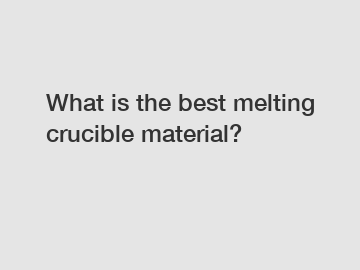What is the best melting crucible material?
When it comes to melting materials in a crucible, choosing the right crucible material is essential for achieving optimal results. The melting crucible material plays a crucial role in determining the efficiency and effectiveness of the melting process, as well as the quality of the final product. There are several different materials commonly used for crucibles, each with its own unique properties and advantages. In this blog post, we will explore some of the most popular crucible materials and discuss their pros and cons to help you determine the best melting crucible material for your specific needs.
One of the most commonly used materials for crucibles is graphite. Graphite crucibles are known for their excellent thermal conductivity, high melting point, and resistance to chemical erosion. These crucibles are ideal for melting metals such as gold, silver, copper, and aluminum, as they can withstand the high temperatures required for these processes. Graphite crucibles are also relatively inexpensive and easy to clean, making them a popular choice for many applications.
However, graphite crucibles are not without their drawbacks. They are susceptible to oxidation at high temperatures, which can lead to contamination of the melted material. In addition, graphite crucibles are not suitable for use with certain reactive metals, such as titanium and zirconium, as they can react with the graphite and cause impurities in the melted metal. For these applications, a different crucible material may be more appropriate.

Another popular crucible material is ceramic. Ceramic crucibles are made from materials such as alumina, zirconia, and silicon carbide, which offer excellent resistance to high temperatures and chemical erosion. Ceramic crucibles are ideal for melting reactive metals and alloys that cannot be melted in graphite crucibles. They are also highly durable and have a longer lifespan than graphite crucibles, making them a cost-effective option for long-term use.
However, ceramic crucibles can be more expensive than graphite crucibles, and they are more fragile and prone to cracking or shattering if mishandled. Additionally, ceramic crucibles have lower thermal conductivity than graphite crucibles, which can result in longer melting times and less efficient heat transfer during the melting process. Despite these drawbacks, ceramic crucibles are a popular choice for melting high-purity metals and alloys in applications where contamination is a concern.
In recent years, metal crucibles have also gained popularity for certain melting applications. Metal crucibles are made from materials such as platinum, stainless steel, and nickel, which offer excellent resistance to high temperatures and chemical erosion. Metal crucibles are ideal for melting high-purity metals and alloys that require precise temperature control and low contamination levels. They are also highly durable and can withstand repeated use at high temperatures without cracking or degrading.
However, metal crucibles can be more expensive than graphite or ceramic crucibles, and they may not be suitable for all melting applications. Metal crucibles have lower thermal conductivity than graphite crucibles, which can result in longer melting times and less efficient heat transfer. Additionally, metal crucibles can react with certain metals and alloys, leading to contamination of the melted material. Despite these drawbacks, metal crucibles are a popular choice for melting high-purity metals in specialized industries such as aerospace, electronics, and jewelry manufacturing.
In conclusion, the best melting crucible material for your specific needs will depend on a variety of factors, including the type of material being melted, the required temperature range, and the level of contamination tolerance. Graphite crucibles are a versatile and cost-effective option for melting non-reactive metals such as gold, silver, copper, and aluminum. Ceramic crucibles are ideal for melting reactive metals and alloys that require high purity and low contamination levels. Metal crucibles are a good choice for melting high-purity metals that require precise temperature control and low contamination levels.
Ultimately, the best melting crucible material for your application will depend on a combination of factors, including cost, durability, thermal conductivity, and resistance to chemical erosion. By carefully considering these factors and weighing the pros and cons of each crucible material, you can select the best option to achieve optimal results in your melting processes. Whether you choose graphite, ceramic, or metal crucibles, selecting the right crucible material is key to ensuring the success of your melting operations.
Are you interested in learning more about graphite blocks for casting, How is Graphite Block Made?, carbon artificial graphite block? Contact us today to secure an expert consultation!
193
0
0

Comments
All Comments (0)